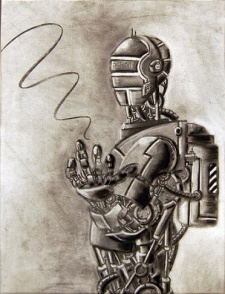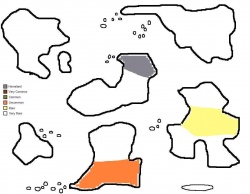Trinity:Artilect

Artilects are probably going to wind up in SteamWorks, so they may not be up here all that long.
Artilects[edit]
After the rise of the Coldlands Territory, there was some amount of interest in producing a mechanical race, primarily to make up for the lack of numbers in the Coldlands. The result of that research were the coglings, but the research in artificial intelligence and robotics paved the way for something greater. Something more... human.
An enterprising young woman by the name of Ada Fralizte took the schematics of the coglings and modified them intensely, making it larger and improving its capabilities. She improved its cognition, taking the machine from a hivemind-esque device to something with all of its cognition performed internally. As she progressed, she realized that - in order to improve some aspects of the artilect - other aspects had to be diminished; she tracked these changes, however, and ended with seven distinct designs. She then began constructing them, sometimes out of modified coglings, sometimes out of spare parts, and sometimes a combination of the two.
Before she died, Ada constructed twenty-seven artilects, each varying in appearance and construction. However, these beings were capable of replicating themselves, equipped with the ability to give their "offspring" different abilities than themselves. Before long, artilects became a rather large segment of the Coldlands population; they also spread to other continents and worlds. With their cognition wholly self-contained, artilects did not face the difficulties that coglings did in gaining recognition as sentient beings: artilects have managed to integrate themselves into society relatively seamlessly.
Personality: Artilects are not incapable of emotion, though their general lack or misunderstanding of it is one of their defining features. Artilects are much like humans in that their personalities are defined by their experiences; no two artilects are the same, on a personality standpoint, though they will often be rather similar in outlook.
Physical Description: Usually, the only thing that two given artilects share - in a physical sense - is that they are made entirely of inorganic materials. The standard artilect stands at roughly six feet tall, though a given artilect's form will usually reflect its particular "evolution," as it was given by its parent artilect. Sibling artilects will often begin life with similar appearances, though an artilect often modifies itself to make itself distinct. The majority of artilects are constructed from iron and steel, though rarely they have been constructed of titanium or orichalcum; some elements of an artilect may also be constructed of more exotic materials (for instance, artilects from Arcturas often use electrum as a power source.
Relations: While they may appear humanoid, artilects are alien in almost every sense to organic races. Their logic skills are unequaled, save by coglings, and this may be off-putting to other races. However, they are generally regarded with at least some degree of respect by most races. Moogles, dwarves, and gremlins tend to get along especially well with artilects, as these races share a common interest in technology. Artilects tend to get along especially well with coglings, sharing a sort of camaraderie with them, given that both races are artificially-constructed.
Alignment: The initial outlook of an artilect is lawful, given that its very method of thinking is purely logical in nature. Artilects tend to be neutral in regards to good and evil, looking at everything in terms of logic and illogic, though this outlook often changes as the artilect gains experience. Rarely is an artilect chaotic.

Artilect Lands: Artilects call the Coldlands Territory their homeland, their origins being traceable to a single person who lived there. However, over time, artilects have spread out across the globe.
Religion: The concept of religion is often a difficult one for an artilect to grasp. Artilects who discover it may sometimes revere Relofis, the patron of technology; others may regard Ada Fralizte as a Saint, even though she is not recognized as such.
Language: Artilects think in Assembly; unlike other races, they are incapable of forgetting this language, as it is what enables them to think in the first place. Artilects pick up on language rather quickly, though cultural nuances and tonality often escape them.
Names: Names are a product of imagination, which is something that most artilects have little experience with. As such, artilect names run the gamut: some are named after everyday objects, some are named after myths or books, while others have genuinely invented names. An artilect may sometimes rename itself as it grows older, seeking a way to individualize itself.
Adventurers: Artilects are prone to adventure, seeking out new experiences. While the majority prefer to find a routine and stick to it, some artilects find that they are drawn to strange experiences, relishing in the strange emotions and actions of other creatures. By adventuring, an artilect almost guarantees that it will have new experiences.
Artilect Racial Traits[edit]
- +2 Int, -2 Wis, -2 Cha.
- Construct (Mechanical, Cognizant): Artilects are constructs with the mechanical and cognizant subtypes. As a cognizant creature, artilects differ from standard constructs in the following ways:
- An artilect derives its HD, BAB, saves, and skill points from its class.
- An artilect has a Constitution score.
- An artilect does not have low-light vision or darkvision.
- An artilect is not immune to mind-affecting effects.
- An artilect does not heal normally.
- An artilect can be affected by spells, powers, and devices that target living creatures, as well as those that target constructs. However, spells from the healing subschool or supernatural abilities that cure hit point or ability damage provide only half their normal effects to an artilect.
- An artilect suffers unusual effects from certain spells or powers that don't normally target living creatures. Heat metal and chill metal affect the artilect as though it were wearing heavy armor. Likewise, an artilect is affected by repel stone or metal as though wearing heavy armor. The iron in the body of an artilect makes it susceptible to rusting grasp; such a spell deals 2d6 points of damage to the artilect (Fort half, DC 14 + caster's ability modifier); it is likewise affected by a rust monster's touch (DC 17), or a rust dragon's breath weapon (DC as normal).
- An artilect responds to damage differently than mortal characters. An artilect with 0 to -10 hit points is inert; it is unconscious and helpless, but does not lose any more hit points (mortal characters lose hit points by bleeding).
- An artilect can be raised or resurrected; however, divine magic can never restore an artilect to life except by a cleric with access to the Metal, Craft, or Technology domains.
- An artilect does not need to eat, sleep, or breathe, and it cannot benefit from consumable spells; however, it can consume potions normally. Also, though the artilect does not have organic skin, it can benefit from psionic tattoos.
- An artilect, though not requiring sleep, must rest for 8 hours before preparing spells, regaining power points, or any other Force-related powers.
- Medium-size.
- Artilect base land speed is 30 feet.
- Mechanical Evolution (Ex): Artilects are continually improving themselves; each new generation of artilects is faster, stronger, and smarter than the one before it. At character creation, an artilect chooses one of the following abilities.
- Enhanced Servos: The artilect has an improved network of servos and hydraulic pumps, allowing it to haul and lift more weight than normal. The artilect gains a +2 racial bonus to Strength, and can wield weapons as though it were one size larger.
- Lightweight Material: The artilect has been built from materials that are lighter than typical iron and steel, such as an alloy or metallic compound - as such, it has greatly improved response time from its appendages. The artilect gains a +2 racial bonus to Dexterity, and its base land speed is 40 feet.
- Durable Construction: The artilect has been built sturdily, much more compact and resistant to damage. Due to this, it can withstand more punishment than other artilects. The artilect gains a +2 racial bonus to Constitution, and has DR 1/-.
- Expansive Neural Network: The artilect's mechanical intelligence algorithms are faster than those of other artilects, thanks to an expansive neural network. The artilect gains a +2 racial bonus to Intelligence (this stacks with the standard +2 racial bonus), and gets an additional favored class of its choice.
- Intuitive Algorithms: The artilect's programming allows it a degree of intuition than is almost human. As such, the artilect gains a +2 racial bonus to Wisdom (this stacks with the standard -2 racial penalty), a +2 racial bonus to Initiative checks, and trap sense +1 (as per the rogue ability).
- Human Behaviors: The artilect has a degree of humanity in its decisions and appearance, making mortals more amenable to its presence. The artilect gains a +2 racial bonus to Charisma (this stacks with the standard -2 racial penalty), and gains Humanoids as a Favored Enemy (as per the ranger ability).
- Finetuned Sensors: The artilect's sensors are finely tuned, allowing it a greater degree of physical sensation. The artilect gains a +2 racial bonus to Perception, as well as darkvision of 60 feet.
- Composite Plating: The artilect is covered in material that makes it difficult to damage its delicate machinery, granting it a +2 armor bonus to AC. This composite plating occupies the same space on the body as a suit of armor or a robe. An artilect can be technologically-enhanced as though it were armor, but the artilect must be present for the entire time it takes to modify it. Composite plating also provides the artilect with a 5% arcane spell failure chance.
- Natural Weapon: An artilect has a natural weapon, in the form of a slam attack that deals 1d4 points of bludgeoning damage.
- Resistances (Ex): Artilects have SR and PR equal to their level. These resistances overlap (do not stack) with resistances gained due to class.
- Automatic Languages: One Common language, one Trade language, Assembly. Bonus Languages: Any.
- Favored Class: Any. At character creation, an artilect may choose a single class as its favored class.
- LA: +1.
Artilect Subraces[edit]
What follows are the artilect subraces and how they differ from what is listed above.
Arcturan Artilect[edit]
Artilects that were constructed on Arcturas were unable to take advantage of the power systems available on Adnez, given that there were limited facilities to construct artilects with, as well as limited resources. Arcturan artilects differ from other artilects in that their powersource is electrum, and they are equipped with the systems required to extract power from that material. However, given the fact that electrum must recharge in order to continue supplying power, arcturan artilects differ from normal artilects in some fashion.
Arcturan artilects are as per normal artilects, with the following differences.
- An arcturan artilect must spend 8 hours per day recharging, as its power is drawn from electrum. An arcturan artilect can operate for up to 32 hours before it must recharge; however, if an arcturan artilect remains active for more than sixteen hours, it becomes fatigued until it rests.
- Electricity Reaction (Ex): An arcturan artilect's power is derived from electricity; as such, they react unpredictably to electrical power. When an arcturan artilect takes an amount of electricity damage equal to or greater than its Constitution score, it acts as though affected by haste, as per the spell (if it was fatigued from not recharging its batteries, it is no longer fatigued); this lasts for 1d4+1 rounds, after which the artilect is fatigued as though from not recharging its electrum.